Ultra Probe
By Marcus Lindroos.
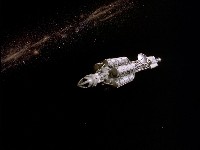
|
The Ultra probe appeared in the Dragon's Domain episode. It is a large manned interplanetary exploration vessel, presumably nuclear powered like the Eagle and Hawk spacecraft. The main propulsion system consists of two large rocket engines plus four auxiliary manoeuvring engines. The design seems very credible, with two groups of six propellant tanks clustered around the ~70 metre long cylindrical core section which may contain additional propellant tankage as well as the main habitation module. The latter is housed within the widebody section immediately behind the detachable "command module" nosecone section. No landing gear is visible and the Ultra probe is probably only designed for missions from one planetary orbit to another. The ship seems to have large enough propellant tanks for a slow (2-3 years duration) mission to Mars or Venus orbit. Longer missions to the outer planets became feasible after anti gravity screens were introduced (note that the ship has artificial gravity). The ship carries enough food and supplies to support a crew of four for at least fifteen months in space. |
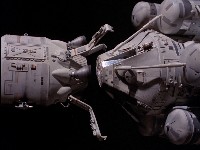
|
The Ultra probe is normally controlled from a small "command module" cockpit section. Normally docked to the front end of the main Ultra probe ship, the command module is capable of independent space missions lasting up to six months. It can be used as a "lifeboat" in an emergency, but it is probably mainly intended as a short range planetary landing craft. The command module could easily land on minor celestial bodies such as asteroids using its built-in propulsion system only (the module carries four small engines). Antigravity screens may permit landings on larger planets such as Ultra. |
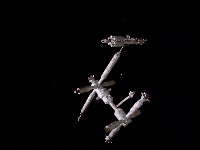
|
The Ultra probe is refuelled and refurbished at the space station. It is quite possible that these are the oldest spacecraft seen in Space:1999. The Ultra probe contains lots of equipment that also appeared in Gerry Anderson's earlier TV series UFO set in the early 1980s, so it may have become operational at around the same time. The similar Eagle Transporter, Hawk and Meta probe ship may be slightly modernised "block II" designs that entered service a few years later in the mid-1980s, shortly before the outbreak of the short but devastating world war in 1987. Keith Young has suggested that the Ultra probe might be an "Astro"-class spaceship similar to the one lost near Jupiter in 1994 (Matter of Life and Death) |
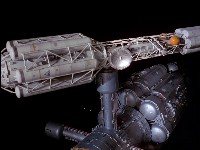
|
Ultra probe docking with the alien ship. One entry hatch is supposedly located on the underside of the core section. Another seems to be on the starboard side of the habitation module (the exterior is never seen in the episode) Note large communications antenna dish in the middle, and the orange propellant tank pressurisation spheres in front of the aft tanks. Additional external propellant tanks can presumably be added to the central section to further extend the ship's range. |
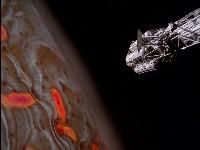
|
Although the Ultra probe itself seems very credible, the same cannot be said about the mission to planet Ultra, alas. There are at least two major problems:
Ultra was probably detected while still at a great distance from the solar system. Keith Young has suggested that Ultra in fact is the fifth major planet from the sun, but it was never detected since its orbit takes it high above and below the orbital plane of Earth. It is an interesting but unlikely idea; to an observer on Earth, the planet would still appear as bright as Mars and it would be easily detectable despite sometimes appearing in unfamiliar "territory" in the night sky. Ultra's gravity pull would also have tremendous impact on the asteroid belt, causing easily detectable disturbances. It seems far more likely that Ultra is an extrasolar planet from interstellar space that only briefly passes through our solar system. It would most likely be a young protoplanet that has not yet cooled down. Planetary scientists suspect young protoplanets are frequently ejected from their solar system of origin because of close encounters with other planets. It would still be warm as it entered our solar system hundreds of thousands of years later. Life might be possible around the numerous volcanic "hot spots" and lava flows on its surface. If the planet retained a dense atmosphere of hydrogen, geothermal heat would be trapped, so the surface might have temperatures similar to Earth and water oceans. |
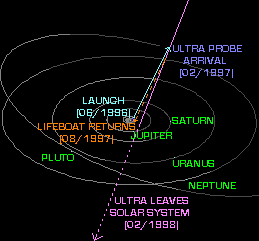 |
Regarding Ultra's orbit, it would seem that the planet is rapidly approaching the inner solar system from interstellar space. The Ultra probe rendezvoused with Ultra about half a year prior to closest approach, while the planet is still beyond the orbit of Uranus or Neptune. This implies the main Ultra spacecraft must be capable of high speed space travel -- hundreds of kilometres per second -- in order to reach the edge of our solar system in just eight months. Cellini's command module lifeboat only needs to slightly increase its velocity to leave its parking orbit around Ultra, however, since it still shares the planet's general motion through space. The lifeboat would sail helplessly past Earth and continue into interstellar space, but it is intercepted and brought back to Alpha by a rescue team (see diagram). |
Copyright Martin Willey